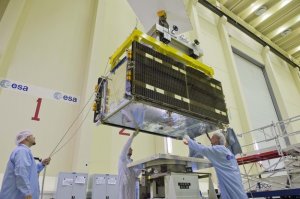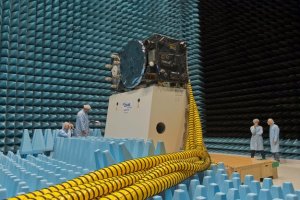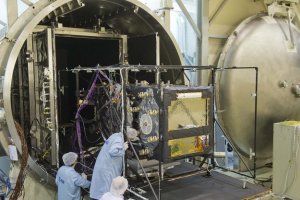The 22 FOC Galileo satellites being built by OHB in Germany with a payload from Surrey Satellite Technology Ltd in the UK will pass through ESTEC for testing on their way to launch in the next few years.
The testing of the first two FOC satellites, already in ESTEC, is especially rigorous because the overall design is being validated, while the next batch of satellites will undergo lighter acceptance testing instead.
The third Galileo satellite is expected to arrive at ESTEC in March, with further satellites following every seven weeks or so. This is the set of tests that Galileo satellites may pass before their launch within a Soyuz rocket in Kourou spaceport:
Mass property test: Checks that the satellite’s centre of gravity and mass are aligned within design specifications. The more precisely these are known, the more efficiently the satellite’s orientation can be controlled with thruster firings in orbit, potentially elongating their working life by conserving propellant.
Electromagnetic compatibility testing in the Maxwell Test Chamber: the shielded walls block out all external electrical signals and spiky, radio-absorbing anechoic material lining the chamber. Isolated within the chamber as if in space, the satellite could be switched on to check all its systems can operate together without interference.
Acoustic testing in the Large European Acoustic Facility (LEAF): A quartet of noise horns are embedded in one wall of this 11 m-wide, 9 m-deep and 16.4 m-high chamber, generating sound by passing nitrogen gas through the horns, surpassing 140 decibels in all. Accelerometers placed within the satellite checked for potentially hazardous internal vibration during this trial by sound.
Thermal-vacuum test: the Galileo satellite is placed inside the Phenix chamber, 4.5 m-diameter stainless steel vacuum chamber. Once inside, the air is pumped out to create a space-quality vacuum at the same time as the temperature extremes in Galileo’s planned orbit is also reproduced.
Vibration and shock testing: The spacecraft was vibrated on the shaker tables, simulating the violent forces of a rocket launch. Up-and-down vibration on the QUAD shaker followed by side-to-side shaking on the horizontal shaker, with data gathered across hundreds of channels.
Separation from dispenser simulation: Finally the satellite is then connected to the dispenser that will hold it during launch to simulate the separation at the end of its climb to orbit. This separation is triggered by firing a pyro device which then pushes the satellite away from the dispenser.





Thanks for sharing the information